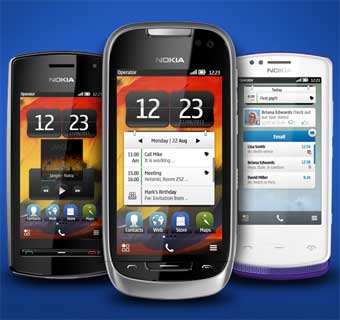Troubled handset giant Nokia has unveiled the latest flavour of its Symbian operating system, which it will use to attack the mass market smartphone sector. Symbian Belle is the latest in a series of planned software updates, increasing the number of home screens from three to six and enhancing the capabilities of live widgets.
August 25, 2011

Troubled handset giant Nokia has unveiled the latest flavour of its Symbian operating system, which it will use to attack the mass market smartphone sector. Symbian Belle is the latest in a series of planned software updates, increasing the number of home screens from three to six and enhancing the capabilities of live widgets.
Keeping up with market trends, Symbian Belle features single-tap NFC sharing and pairing capability, which allows contacts, videos and images to be shared with other NFC-enabled devices, as well as pairing with NFC-enabled accessories such as speakers and headsets.
The 700 is Nokia’s smallest smartphone to date, weighing 96gm with dimensions of 110 x 50.7 x 9.7 mm, a 1Ghz processor, 3.2 inch AMOLED screen and 2GB of internal memory and 5MP full focus camera with LED flash.
Moving up the scale is the 701, based on a 3.5 inch ClearBlack display, with a 1GHz processor, 8MP full focus camera with dual LED flash and 2 X digital zoom, 2nd front-facing camera and HD video capture. It comes with 8GB internal memory.
While at the lower end is the 600, with built-in FM radio antenna and FM transmitter, supported by an internal loudspeaker, 1 GHz processor; 5MP full focus camera with LED flash and HD video capture, and 2GB of internal memory.
“With the announcement today Nokia has made it clear that Symbian will continue to play an important role in its product portfolio alongside Windows Phone 7,” said Nick McQuire, analyst with IDC. “There is a sense of urgency in the way improvements and innovation are being delivered to the platform that demonstrates how committed Nokia is to make Symbian products a competitive smartphone choice.”
Nokia outsourced development of the floundering operating system to consultancy Accenture back in April, transitioning some 3,000 employees to the firm as part of the deal. Symbian will continue to be used on Nokia’s mass market devices, while Microsoft’s Windows Phone will provide the basis for the top tier offerings.
Nokia’s new plan is being executed but the firm is by no means out of the woods. The firm recently said its difficulties are such that it was no longer appropriate to provide annual targets for 2011. Nokia is being undercut in the low end, high volume segment of the market by increasingly powerful Chinese manufacturers with far lower cost bases. Meanwhile it is still anonymous in the lucrative smartphone segment, where its partnership with Microsoft has yet to bear fruit. CEO Stephen Elop came close to promising that this situation would change before the year is out, saying: “We have increased confidence that we will ship our first Nokia product with Windows Phone in the fourth quarter 2011.”
About the Author(s)
You May Also Like








.png?width=300&auto=webp&quality=80&disable=upscale)


_1.jpg?width=300&auto=webp&quality=80&disable=upscale)


.png?width=800&auto=webp&quality=80&disable=upscale)